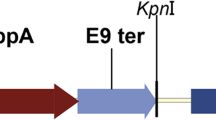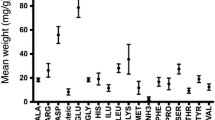Abstract
Esterases are enzymes that present good potential in industrial application, and soybean seed can represent an alternative source for this enzyme. The extraction and esterase activity of Brazilian soybean seeds (Glycine max L.) were evaluated. Esterase activity was found in both the germinated and non-germinated seeds at 2.90 and 1.70 U/mg, respectively, with a concentration in the powdered extract (freeze dried) of 100 mg/mL. The enzyme showed a preference for the hydrolysis of short chain fatty acids (120.02 U/mL) and optimum pH for activity was pH 8.0 with optimum temperatures of 40 and 80°C. The enzyme showed stability at 70°C showing 60% of residual activity and activity increased with the addition of the following salts: NaNO3, K2SO4, and Na2SO4 in the reaction medium.
Similar content being viewed by others
References
Mohamed MA, Mohamed TM, Mohamed SA, Fahmy AS. Distribuition of lipases in the graminae. Partial purification and characterization of esterase from Avena fatua. Bioresource Technol. 73: 227–234 (2000)
Maia MA, Heasley A, de Morais MMC, Melo EHM, Morais Jr MA, Lendingham WM, Lima Filho JL. Effect of culture conditions on lipase production by Fusarium solani in batch fermentation. Bioresource Technol. 76: 23–27 (2001)
Panda T, Gowrishankar BS. Production and applications of esterases. Appl. Microbiol. Biot. 67: 160–169 (2005)
Singh R, Gupta N, Goswami VK, Gupta RS. Simple activity staining protocol for lipases and esterases. Appl. Microbiol. Biot. 70: 679–682 (2006)
Fahmy AS, Abo-Zeid AZ, Mohamed TM, Ghanem HM, Borai IH, Mohamed AS. Characterization of esterases from Cucurbita pepo cv. Eskandrani. Bioresource Technol. 99: 437–443 (2008)
Freire GDM, Castilho FLR. Lipases in biocatalysis. pp. 369–385. In: Enzyme in Biotechnology Production, Application, and Market. Bom EPS, Ferrara MA, Corvo ML (eds). Interciências, Rio de Janeiro, Brazil (2008)
Barros M, Fleuri LF, Macedo AG. Seed lipase: Sources, applications, and properties-A reveiew. Braz. J. Chem. Eng. 27: 15–29 (2010)
Hasan F, Shah AA, Hameed A. Industrial applications of microbial lipases. Enzyme Microb. Tech. 39: 235–251 (2006)
Ruchi G, Anshu G, Khare SK. Lipase from solvent tolerant Pseudomonas aerufinosus strain: Production optimization by response surface methodology and application. Bioresource Technol. 99: 4796–4802 (2008)
Mukherjee KD, Hills MJN. Lipases from plants. pp. 271–288. In: Lipases-Their Structure, Biochemistry, and Application. Wooley P, Peterson SB (eds). Cambridge University Press, Cambridge, UK (1994)
Paques FW, Macedo GA. Lipases latex plants: Properties and applications industries. Quim. Nova 29: 93–99 (2006)
Hellyer SA, Chandler IC, Bosley JA. Can the fatty acid selectivity of plant lipases be predicted from the composition of the seed triglyceride? Biochim. Biophys. Acta 1440: 215–224 (1999)
Villeneuve P. Plant lipases and their applications in oils and fats modification. Eur. J. Lipid. Sci. Tech. 105: 308–317 (2003)
Enujiagha VN, Thani FA, Sanni TM, Abigor RD. Lipase activity in dormant seeds of the African oil bean (Pentaclethra macrophylla Benth). Food Chem. 88: 405–410 (2004)
Polizelli PP, Tiera MJ, Bonilla-Rodriguez GO. Effect of surfactants and polyethylene glycol on the activity and stability of a lipase from oilseeds of Pachira aquatica. J. Am. Chem. Soc. 85: 749–753 (2008)
Liaquat M, Apenten RKO. Synthesis of low molecular weight flavor esters using plant seedling lipases in organic media. J. Food Sci. 65: 295–299 (2000)
Sagiroglu A, Arabaci N. Sunflower seed lipase: Extraction, purification, and characterization. Prep. Biochem. Biotech. 35: 37–51 (2005)
Sadeghipour HR, Bhatla SC. Light-enhanced oil body mobilization in sunflower seedlings accompanies faster protease action on oleosins. Plant Physiol. Bioch. 41: 309–316 (2003)
Sammour RH. Purification and partial characterization of an acid lipase in germinating lipid body linseedlings. Turk. J. Bot. 29: 177–184 (2005)
Huang AHC, Moreau RA. Lipases in the storage tissues of peanut and other oil seeds during germination. Planta 141: 111–116 (1978)
Rakhimov MM, Dzhanbaeva NR, Yuldashev PK. Specify of the lipase from cottonseed. Chem. Nat. Compd+. 6: 616–619 (1970)
Stejskal J, Grica M. Comparative analysis of some isozymes and proteins in somatic and zygotic embryos of soybean (Glycine max L.). J. Plant Physiol.146: 497–502 (1995)
Aizono Y, Funatsu M, Sugano M, Hayashi K, Fujiki Y. Enzymatic properties of rice bran lipase. Agr. Biol. Chem. Tokyo 37: 2031–2036 (1973)
Bradford MM. A rapid and sensitive method for the quantitation of microgram quantities of protein utilizing the principle of protein-dye binding. Anal. Biochem. 72: 248–254 (1976)
Pio TF, Macedo GA. Optimizing the production of cutinase by Fusarium oxysporun using response surface methodology. Enzyme Microb. Tech. 41: 613–619 (2007)
Macedo GA, Pastore GM. Microbial lipases in the production of aroma esters forming. Rev. Soc. Bras. Cienc. Tecnol. Alim. 17: 115–119 (1997)
Hassanien FR, Mukhrjee KD. Isolation of lipase from germinating oilseeds for biotechnological processes. J. Am. Chem. Soc. 63: 893–897 (1986)
Ejedegba BO, Onyeneke EC, Oviasogie PO. Characteristics of lipase isolated form coconut (Cocos nucifera linn) seed under different nutrient treatments. Afr. J. Biotech. 6: 723–727 (2007)
Borek S, Ratajczak W, Ratajczak L. Ultra structural and enzymatic research on the role of sucrose in mobilization the storage lipids in germinating yellow lupine seeds. Plant Sci. 170: 441–452 (2006)
Huang AHC, Lin YH, Wang SM. Characteristics and biosynthesis of seed lipases in maize and other plant species. J. Am. Chem. Soc. 65: 897–899 (1988)
Nwanguma BC, Ezengwa MO, Ezengwa OO. Changes in activity of sorghum lipase malting and mashing. J. I. Brewing 102: 39–41 (1996)
Borgston B, Brockman HL. Lipases. Elsevier, Amsterdam, Netherlands. pp. 5–7 (1984)
Marten B, Pfeuffer M, Scherezenmeir J. Medium-chain triglycerides. Int. J. Dairy Tech. 16: 1374–1382 (2006)
Osborn HT, Akoh CC. Structure lipids-novel fats with medical, nutraceutical, and food applications. Crit. Rev. Food. Sci. F. 3: 110–120 (2002)
Kubicka E, Grabska J, Jedrychowski L, Czyz B. Changes of specific activity of lipase and lipoxygenase during germination of wheat and barley. J. Food. Sci. 51: 301–304 (2000)
Staubmann R, Ncube I, Gübitz GM, Steiner W, Read JS. Esterase and lipase activity in Jatropha curcas L. seeds. J. Biotechnol. 75: 117–126 (1999)
Isbilir SS, Ozcan MH, Yagar H. Some biochemical properties of lipase from bay laurel (Laurus nobilis L.) seeds. J. Am. Chem. Soc. 85: 227–233 (2008)
Yesiloglu Y, Baskurt L. Partial purification and characterization of almond seed lipase. Prep. Biochem. 38: 397–410 (2008)
Author information
Authors and Affiliations
Corresponding author
Rights and permissions
About this article
Cite this article
de Barros, M., Macedo, G.A. Biochemical characterization of esterase from soybean (Glycine max L.). Food Sci Biotechnol 20, 1195–1201 (2011). https://doi.org/10.1007/s10068-011-0165-8
Received:
Revised:
Accepted:
Published:
Issue Date:
DOI: https://doi.org/10.1007/s10068-011-0165-8




